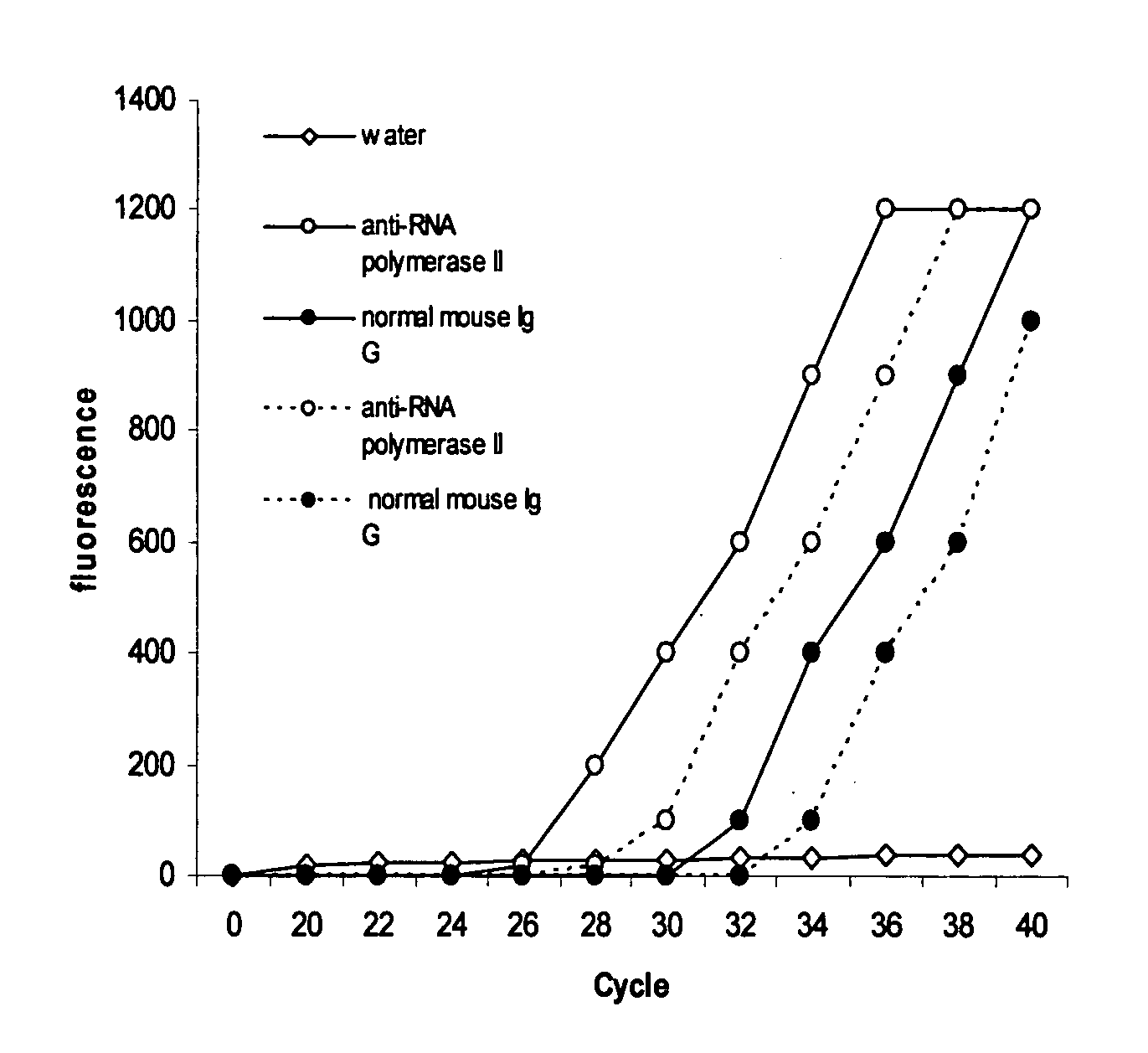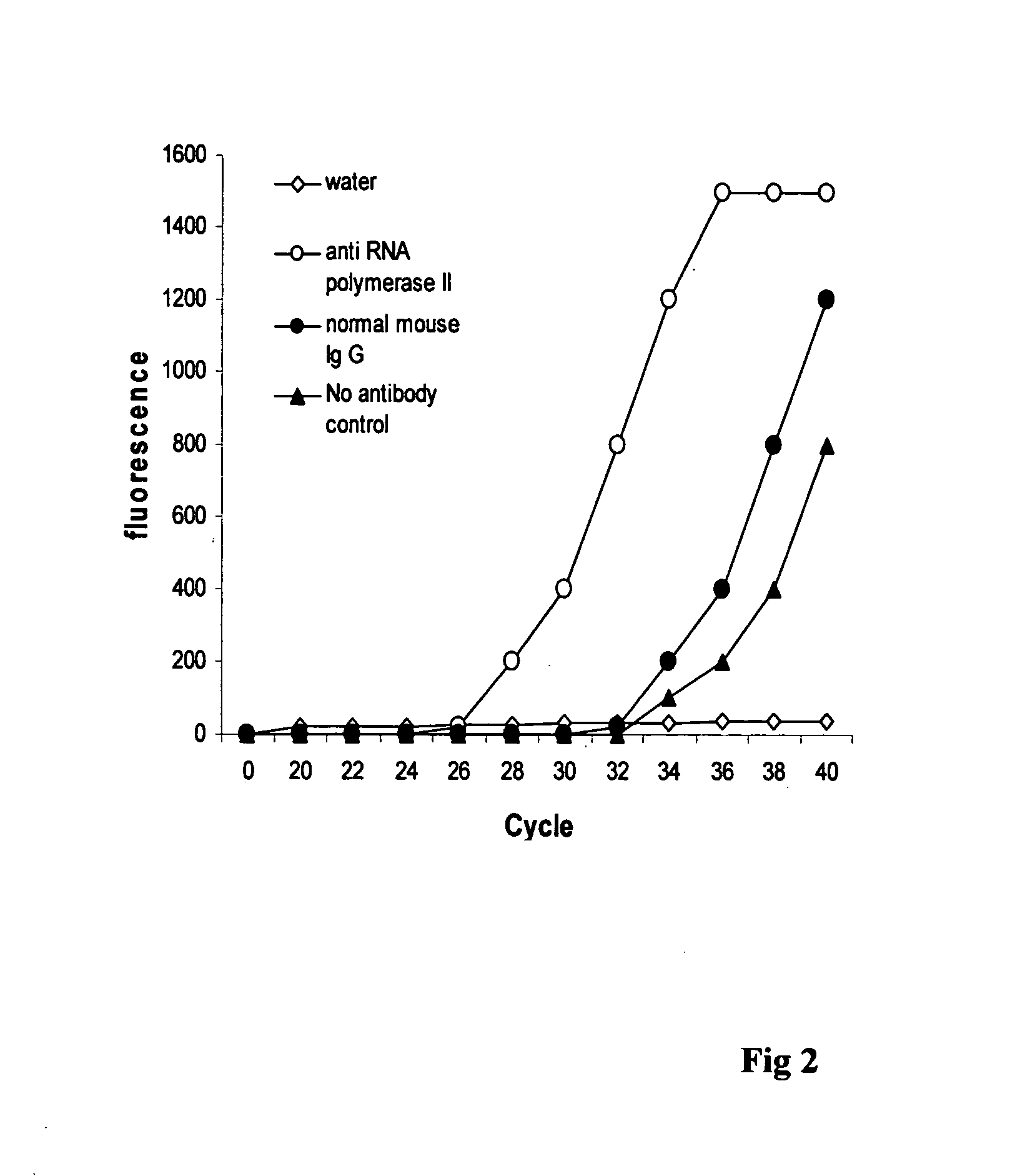Methods of rapid chromatin immunoprecipitation
a chromatin immunoprecipitation and chromatin technology, applied in the field of rapid chromatin immunoprecipitation, can solve the problems of time-consuming and time-consuming current chip method, cannot be used for analyzing dna-protein interactions in living cells, and achieve rapid and efficient chip, rapid and convenient binding, and rapid reverse crosslinked protein-dna complex
- Summary
- Abstract
- Description
- Claims
- Application Information
AI Technical Summary
Benefits of technology
Problems solved by technology
Method used
Image
Examples
example 1
[0030]The experiment was carried out to detect whether a specific protein binds to the specific sequences of a gene in living cells.
[0031]Antibody binding to the assay plate: Wash plate wells twice with wash buffer (100 mM sodium phosphate, 200 mM NaCl, pH 7.4 and 1% Triton X 100). Dilute various antibodies with wash buffer to 10 μg per ml and add 100 μl of diluted antibody to the each well. Normal mouse Ig G was used as the negative control and anti-RNA polymerase II as the positive control. Cover the plate and incubate at room temperature for 60-90 min. The plate was then washed 3-4 times with wash buffer.
[0032]Cell fixation and lysis: Hela cells were grown to 70%-80% confluence on a 100 mm plate, then trypsinized and collected into a 15 ml conical tube. After washing with PBS, cells were suspended in 9 ml of fresh culture medium containing 1% formaldehyde (final concentration) and incubated at room temperature (20-25° C.) for 10 min on a rocking platform (50-100 rpm). 1 ml of gly...
example 2
[0037]The experiment was carried out to compare the effect of the CHIP method of this invention to that of conventional CHIP.
[0038]Antibody binding to the assay plate: Wash plate wells twice with wash buffer (100 mM sodium phosphate, 200 mM NaCl, pH 7.4 and 1% Triton X 100). Dilute various antibodies with wash buffer to 10 μg per ml and add 100 μl of diluted antibody to the each well. Normal mouse Ig G was used as the negative control and anti-RNA polymerase II as the positive control. Cover the plate and incubate at room temperature for 60-90 min. The plate was then washed 3-4 times with wash buffer.
[0039]Hela cells were grown to 70%-80% confluence on a 100 mm plate, then trypsinized and collected into a 15 ml conical tube. After washing with PBS, cells were suspended in 9 ml of fresh culture medium containing 1% formaldehyde (final concentration) and incubated at room temperature (20-25° C.) for 10 min on a rocking platform (50-100 rpm). 1 ml of glycine (1.25 M) was added and incu...
PUM
| Property | Measurement | Unit |
|---|---|---|
| temperature | aaaaa | aaaaa |
| temperature | aaaaa | aaaaa |
| concentration | aaaaa | aaaaa |
Abstract
Description
Claims
Application Information
 Login to View More
Login to View More - R&D
- Intellectual Property
- Life Sciences
- Materials
- Tech Scout
- Unparalleled Data Quality
- Higher Quality Content
- 60% Fewer Hallucinations
Browse by: Latest US Patents, China's latest patents, Technical Efficacy Thesaurus, Application Domain, Technology Topic, Popular Technical Reports.
© 2025 PatSnap. All rights reserved.Legal|Privacy policy|Modern Slavery Act Transparency Statement|Sitemap|About US| Contact US: help@patsnap.com



